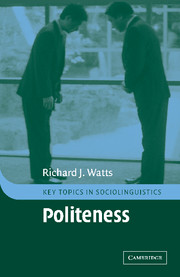Book contents
- Frontmatter
- Contents
- Preface
- 1 Introducing linguistic politeness
- 2 Politeness through time and across cultures
- 3 Modelling linguistic politeness (I)
- 4 Modelling linguistic politeness (II): Brown and Levinson and their critics
- 5 Facework and linguistic politeness
- 6 A social model of politeness
- 7 Structures of linguistic politeness
- 8 Relevance Theory and concepts of power
- 9 Politic behaviour and politeness in discourse
- 10 Politic behaviour and politeness within a theory of social practice
- Notes
- Glossary of terms
- References
- Index
1 - Introducing linguistic politeness
Published online by Cambridge University Press: 24 November 2009
- Frontmatter
- Contents
- Preface
- 1 Introducing linguistic politeness
- 2 Politeness through time and across cultures
- 3 Modelling linguistic politeness (I)
- 4 Modelling linguistic politeness (II): Brown and Levinson and their critics
- 5 Facework and linguistic politeness
- 6 A social model of politeness
- 7 Structures of linguistic politeness
- 8 Relevance Theory and concepts of power
- 9 Politic behaviour and politeness in discourse
- 10 Politic behaviour and politeness within a theory of social practice
- Notes
- Glossary of terms
- References
- Index
Summary
CHARACTERISING POLITE BEHAVIOUR
Most of us are fairly sure we know what we mean when we describe someone's behaviour as ‘polite’. To define the criteria with which we apply that description, however, is not quite as easy as we might think. When people are asked what they imagine polite behaviour to be, there is a surprising amount of disagreement. In an effort to find some kind of consensus we may of course take refuge in very general statements, but our usual way out of the dilemma is to resort to giving examples of behaviour which we, personally, would consider ‘polite’. We might make statements like ‘He always shows a lot of respect towards his superiors’, or ‘She's always very helpful and obliging’, or ‘She speaks really well’, or ‘He always opens doors for the ladies or helps them on with their coats’, etc. Some people feel that polite behaviour is equivalent to socially ‘correct’ or appropriate behaviour; others consider it to be the hallmark of the cultivated man or woman. Some might characterise a polite person as always being considerate towards other people; others might suggest that a polite person is self-effacing. There are even people who classify polite behaviour negatively, characterising it with such terms as ‘standoffish’, ‘haughty’, ‘insincere’, etc.
Moving from evaluations of polite behaviour in general to the more specific case of polite language usage, i.e. ‘polite’ language, we encounter the same types of problem.
- Type
- Chapter
- Information
- Politeness , pp. 1 - 26Publisher: Cambridge University PressPrint publication year: 2003
- 1
- Cited by

